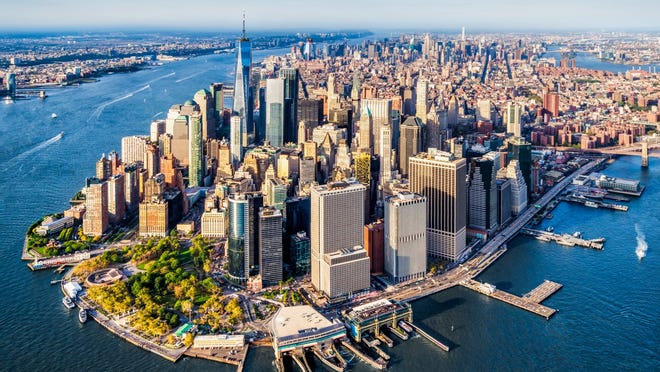Costs curbed by COVID-19 in several significant towns
The housing market place has been booming during the COVID-19 crisis, but America’s metropolitan areas are taking it on the chin.
And though big metropolitan areas like New York and San Francisco, in unique, are having difficulties with falling price ranges, values in fewer densely populated cities this kind of as Phoenix and Charlotte, North Carolina, are holding up reasonably effectively, a new analysis exhibits.
The analyze underscores that the spread of the virus and the pattern towards distant function are driving the housing market, and may possibly continue on to restrain cost progress in very crowded urban places while boosting gains in a lot more suburban areas for some time.
Since the virus started to acquire a considerable toll on general public wellness and the overall economy in March, lots of People in america have been fleeing towns for suburban and rural regions each to minimize the chance of contagion and acquire edge of remote work guidelines for the duration of the disaster, claims economist Troy Ludtka of Natixis, an financial investment banking firm. Those people things, he states, have bolstered household profits. Analysts imagine the teleworking change will at least partly continue even right after the outbreak is above.
Also, a lot of Individuals, who are nevertheless spending an inordinate share of their times at residence irrespective of gradual enterprise reopenings, are hunting for houses with far more indoor and out of doors area, according to Redfin, a countrywide actual estate brokerage.
Incredibly hot vehicles:These 1990s automobiles are in demand on the collectible car market place
Where by to lease a house during COVID-19 :Wherever are rents soaring and slipping the most in major metropolitan areas right after COVID-19?

Also underpinning potent revenue are traditionally reduced property finance loan fees, claims Todd Teta, chief product or service officer for ATTOM Info Options, a real estate study firm.
In the 4 months ending Sept. 20, residence sales ended up up 13.6% on a yearly basis in U.S. suburbs, 13% in rural regions and 8.8% in city regions, according to a Redfin analyze. Home price ranges rose 16.6% in rural regions, 13.7% in the suburbs and 13.1% in city districts, Redfin figures clearly show.
In several situations, the most densely populated towns have endured sharper price declines or really modest boosts for the reason that of greater contagion risk, in accordance or a Natixis evaluation.
“There’s a bifurcation,” Ludtka suggests. “People are considerably less most likely to buy households in places where by they could get sick.”
Amid 20 metropolitan areas in the S&P CoreLogic Case-Shiller’s composite cost index, 11 fell brief of the 2.9% nationwide price get from March by means of July (the most the latest knowledge offered) though 9 topped that improve. New York and San Francisco, the two most crowded towns – at 28,000 and 19,000 citizens for each square mile, respectively – have been most affected by depressed price ranges, the Natixis examination shows.
In New York, selling prices fell for 3 straight months and were being down .3% in July from March levels, Natixis figures show. In San Francisco, selling prices dipped in two of the most the latest a few months charges and ended up up fewer than 1% since March.
Amid other underperformers, selling prices edged up 1.5% in Miami (ranked fourth in density), 2.4% in Chicago (ranked fifth), 2.6% in Los Angeles (rated 10th), and 2.6% in Washington, D.C. (rated seventh).
Trade war redux?:Trump administration imposes aluminum tariffs on $2B imports from 18 nations around the world
Other measures show even sharper cost declines in some places. Median charges in Manhattan tumbled from $1.7 million in February to $1.2 million in June, in accordance to ATTOM Information Answers, a serious estate exploration business.
In the meantime, significantly less tightly-packed cities fared superior than normal. From March to July, prices increased 4% in Phoenix (rated 34th), 3.2% in San Diego (ranked 23rd), and 3.4% in Charlotte (rated 37th), in accordance to the Natixis information.
“Some of the most preferred sites to purchase a residence are in the suburban outlying regions of main metropolitan areas,” suggests Daryl Fairweather, Redfin’s chief economist.
Not every single crowded metropolis is viewing residence prices undergo because of the pandemic and not all metropolitan areas with much more elbow area are prospering, the research demonstrates, due to the fact other factors this kind of as an area’s economic system could loom larger sized, Ludtka suggests.
Cannabis market:Maine and marijuana: Income of pot for leisure use commence Friday
Boston household rates, for instance, have been up 3.1% in the March-July period of time, though the town ranks 3rd in population density. And charges have increased just 1.8% in Tampa even while the city is a relatively reduced 46th in density.
But there is little question that the pandemic has upended the actual estate sector.
In New York, condominium and co-op profits had just started to get better in January immediately after the 2017 tax code modifications, which curtailed deductions for pricey houses, held down exercise, states Martin Freiman, a Redfin broker. Given that the crisis began, nonetheless, Redfin is handling about 600 revenue a month in Manhattan, down from about 1,100 pre-pandemic, and price ranges have been minimized an common of about 10%, Freiman claims.
“Everybody just still left the town en masse,” he claims. “People just stopped acquiring homes…You have an open property and no a person reveals up.”
If businesses such as Fb and Google return to their New York workplaces to some extent by upcoming spring, Freiman foresees young pros aiding rejuvenate the market place. But a different fertile buyer segment – vacant nesters searching to patronize Broadway and other town features – could be diminished long phrase, with older People in america more vulnerable to COVID-19.
